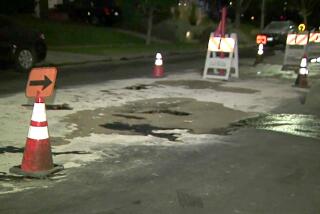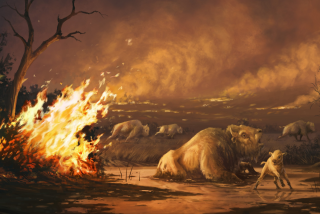How did the La Brea tar pits’ first fiberglass mammoth get there?
The famous fiberglass mammoths at the La Brea tar pits have kept watch over Wilshire Boulevard for five decades.
But few who gaze at the tourist attraction know how the prehistoric “creatures” got there. It turns out the first one got a lift from a 1958 Volkswagen.
In 1967, The Times reported:
“A life-sized model of an imperial mammoth was placed beside the largest of the tar pits in Hancock Park Wednesday, the first of 50 prehistoric animals’ replicas to be installed in the park in a plan to recreate a ‘Pleistocene atmosphere.’
Sculptor Howard Ball, commissioned to do the 13-foot-high, 25-foot-long, fiberglass creature, pulled it to the site from his Torrance studios on a trailer with his 1958 Volkswagen.
The 2,000-pound mammoth was then transferred with a minimum of difficulty by city crane to the four small iron platforms upon which it will rest.
A crowd of about 100 persons, including two county supervisors, the head of the Los Angeles County Museum of Natural History, and members of the museum board watched the installation and heard brief speeches.
Imperial mammoths roamed the Los Angeles area in the Pleistocene epoch of 14,000 to 40,000 years ago. Some became mired in the tar pits.
Ball, the 60-year-old sculptor, said he plans to set to work on a female companion for his $4,300 mammoth immediately. He also plans a baby.
Howard Ball’s three-mammoth installation was finished in 1968.”
And the rest is prehistoric. Until 1992, when one of the mammoths started moving. Really.
The Times reported:
“Amid heavy rains, the fiberglass figure of a half-submerged female Columbian mammoth broke loose from its mooring and suffered the same fate as millions of creatures, large and small, over the last 40,000 years. It got stuck in the asphalt deposits that ooze to the surface throughout the area and make the tar pits the richest cache of Ice Age fossils in the world.
Until the fiberglass beast became mired, it was part of a mammoth family group created by sculptor Howard Ball and installed in 1968. Normally, the female figure looks toward the eastern shore of the lake, where her 10-foot-tall mate and pony-sized infant are waiting. The female has her head thrown back as if roaring a warning to her family, perhaps urging them to keep an eye peeled for saber-toothed cats.
According to Page museum staffers, the shift in the sculpture’s position has been noted by a number of sharp-eyed visitors. ‘One person came in and said, “Did you know your mammoth is loose?”’ said Shelley Cox, supervisor of the museum’s laboratory.”
Last year, the mammoths got some beauty work done to fix cracks and other signs of age.
More to Read
Sign up for Essential California
The most important California stories and recommendations in your inbox every morning.
You may occasionally receive promotional content from the Los Angeles Times.










